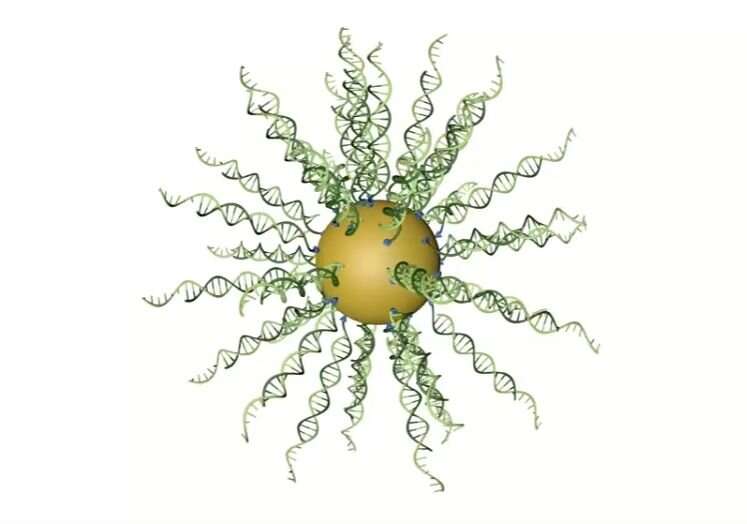New spherical nucleic acid 'drug' kills tumor cells in humans with glioblastoma

An early clinical trial in individuals with the deadly brain cancer, glioblastoma, showed an experimental spherical nucleic acid (SNA) drug developed by Northwestern University scientists was able to penetrate the blood-brain barrier and trigger the death of tumor cells.
This is the first time a nanotherapeutic has been shown to cross the blood-brain barrier when given through intravenous infusion and alter the genetic machinery of a tumor to cause cell death. The drug crossed the blood-brain barrier, dialed down the level of a cancer-causing gene and promoted tumor cell death.
The Northwestern Medicine study will be published March 10 in Science Translational Medicine. The results build upon previously published pre-clinical research by the Northwestern team.
"We showed the drug, NU-0129, even at very small doses, causes tumor cells to undergo what's called apoptosis or programmed cell death," said lead investigator Dr. Priya Kumthekar, an associate professor of neurology at Northwestern University Feinberg School of Medicine and a Northwestern Medicine physician. "It's a remarkable finding in humans that confirms what we had previously seen in our animal studies."
Now Northwestern scientists plan to use this technology to advance this type of therapeutic for brain tumor care.
The phase 0 study was conducted with eight individuals who had recurrent glioblastoma at the Robert H. Lurie Comprehensive Cancer Center of Northwestern University. In phase 0, investigators use a small dose of medication to make sure it isn't harmful to humans before they start using it in higher doses in larger clinical trials.
Study participants received the drug intravenously prior to surgery. Following tumor removal, Kumthekar and her team studied the tumors to determine how well the drug crossed the blood-brain barrier and its effect on the tumor cells.
Glioblastoma affects approximately 13,000 to 15,000 patients each year in the United States and is uniformly fatal. There have been no new drugs approved for glioblastoma in the past decade. Scientists said it's been hard to develop a drug that can breech the protective blood-brain barrier and reach the highly aggressive brain tumor.
SNAs look like a Koosh ball
"This unique 3D design has the ability to infiltrate tumor cells to correct the genes inside and make them susceptible for therapy-induced killing," said senior author Alexander Stegh, an associate professor of neurology at Northwestern.
NU-0129 is the first SNA drug developed for systemic use. SNAs are structures consisting of of DNA or RNA arranged around a nanoparticle, which looks like a Koosh ball, Stegh said.
Stegh developed the drug with Chad A. Mirkin, the discoverer and inventor of the SNA platform and the George B. Rathmann Professor of Chemistry at the Weinberg College of Arts and Sciences and director of Northwestern's International Institute for Nanotechnology.
The glioblastoma drug represents a revolutionary new class of drugs. The novel SNA platform on which it is based can be applied to other types of neurological diseases, such as Alzheimer's, Huntington's and Parkinson's, by similarly turning down the genes that lead to those diseases.
Highly unusual drug route
It's highly unusual for a drug to be developed in preclinical research at a university, shepherded through U.S. Food & Drug Administration approval as an investigational new drug and studied in a clinical trial—all within the same university and without funding from a pharmaceutical company. In most cases, a drug is developed and licensed to a pharmaceutical company.
"We want to move the technology forward as quickly as possible because there are patients with a disease with no current cure," Kumthekar said.
Dr. Leon Platanias, director of the Lurie Cancer Center, said, "These exciting findings for the first time support the potential of spherical nucleic acids for drug delivery to brain tumors. They may prove to have important long-term translational implications for the treatment of these tumors."
More information: P. Kumthekar el al., "A first-in-human phase 0 clinical study of RNA interference–based spherical nucleic acids in patients with recurrent glioblastoma," Science Translational Medicine (2021). stm.sciencemag.org/lookup/doi/ … scitranslmed.abb3945















